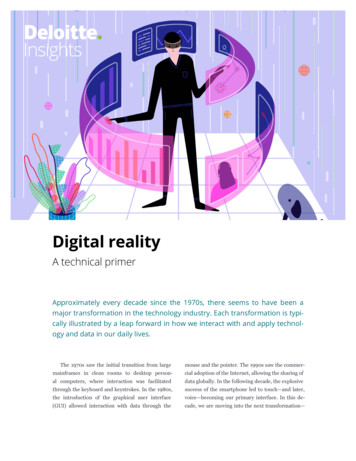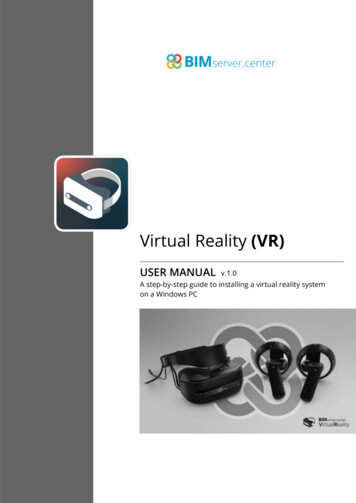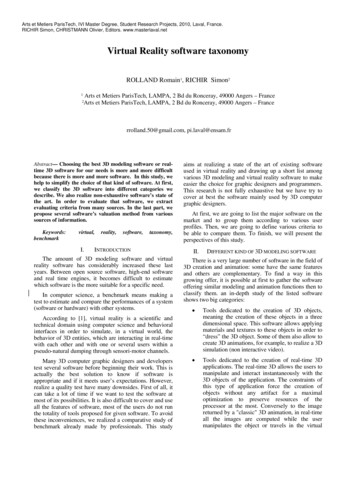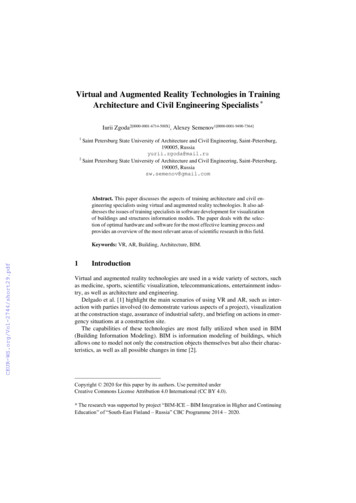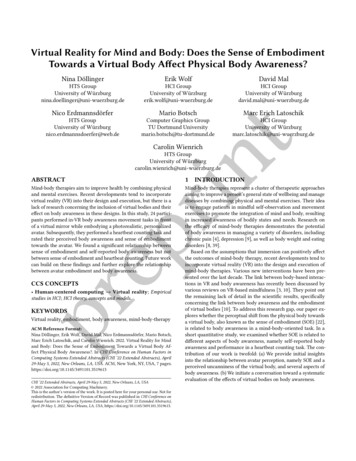
Transcription
Virtual Reality for Mind and Body: Does the Sense of EmbodimentTowards a Virtual Body Affect Physical Body Awareness?Erik WolfDavid MalHTS GroupUniversity of Würzburgnina.doellinger@uni-wuerzburg.deHCI GroupUniversity of Würzburgerik.wolf@uni-wuerzburg.deHCI GroupUniversity of Würzburgdavid.mal@uni-wuerzburg.deNico ErdmannsdörferMario BotschMarc Erich LatoschikHTS GroupUniversity of Würzburgnico.erdmannsdoerfer@web.deComputer Graphics GroupTU Dortmund Universitymario.botsch@tu-dortmund.deHCI GroupUniversity of Würzburgmarc.latoschik@uni-wuerzburg.deCarolin WienrichtNina DöllingerABSTRACTinHTS GroupUniversity of TIONMind-body therapies represent a cluster of therapeutic approachesaiming to improve a person’s general state of wellbeing and managediseases by combining physical and mental exercises. Their ideais to engage patients in mindful self-observation and movementexercises to promote the integration of mind and body, resultingin increased awareness of bodily states and needs. Research onthe efficacy of mind-body therapies demonstrates the potentialof body awareness in managing a variety of disorders, includingchronic pain [4], depression [9], as well as body weight and eatingdisorders [8, 39].Based on the assumptions that immersion can positively affectthe outcomes of mind-body therapy, recent developments tend toincorporate virtual reality (VR) into the design and execution ofmind-body therapies. Various new interventions have been presented over the last decade. The link between body-based interactions in VR and body awareness has recently been discussed byvarious reviews on VR-based mindfulness [3, 10]. They point outthe remaining lack of detail in the scientific results, specificallyconcerning the link between body awareness and the embodimentof virtual bodies [10]. To address this research gap, our paper explores whether the perceptual shift from the physical body towardsa virtual body, also known as the sense of embodiment (SOE) [22],is related to body awareness in a mind-body-oriented task. In ashort quantitative study, we examined whether SOE is related todifferent aspects of body awareness, namely self-reported bodyawareness and performance in a heartbeat counting task. The contribution of our work is twofold: (a) We provide initial insightsinto the relationship between avatar perception, namely SOE and aperceived uncanniness of the virtual body, and several aspects ofbody awareness. (b) We initiate a conversation toward a systematicevaluation of the effects of virtual bodies on body awareness.preprMind-body therapies aim to improve health by combining physicaland mental exercises. Recent developments tend to incorporatevirtual reality (VR) into their design and execution, but there is alack of research concerning the inclusion of virtual bodies and theireffect on body awareness in these designs. In this study, 24 participants performed in-VR body awareness movement tasks in frontof a virtual mirror while embodying a photorealistic, personalizedavatar. Subsequently, they performed a heartbeat counting task andrated their perceived body awareness and sense of embodimenttowards the avatar. We found a significant relationship betweensense of embodiment and self-reported body awareness but notbetween sense of embodiment and heartbeat counting. Future workcan build on these findings and further explore the relationshipbetween avatar embodiment and body awareness.1CCS CONCEPTS Human-centered computing Virtual reality; Empiricalstudies in HCI ; HCI theory, concepts and models.KEYWORDSVirtual reality, embodiment, body awareness, mind-body-therapyACM Reference Format:Nina Döllinger, Erik Wolf, David Mal, Nico Erdmannsdörfer, Mario Botsch,Marc Erich Latoschik, and Carolin Wienrich. 2022. Virtual Reality for Mindand Body: Does the Sense of Embodiment Towards a Virtual Body Affect Physical Body Awareness?. In CHI Conference on Human Factors inComputing Systems Extended Abstracts (CHI ’22 Extended Abstracts), April29-May 5, 2022, New Orleans, LA, USA. ACM, New York, NY, USA, 7 pages.https://doi.org/10.1145/3491101.3519613CHI ’22 Extended Abstracts, April 29-May 5, 2022, New Orleans, LA, USA 2022 Association for Computing Machinery.This is the author’s version of the work. It is posted here for your personal use. Not forredistribution. The definitive Version of Record was published in CHI Conference onHuman Factors in Computing Systems Extended Abstracts (CHI ’22 Extended Abstracts),April 29-May 5, 2022, New Orleans, LA, USA, https://doi.org/10.1145/3491101.3519613.
CHI ’22 Extended Abstracts, April 29-May 5, 2022, New Orleans, LA, USARELATED WORKof the virtual body can either lead to a behavioral shift towardsassociated attitudes and behaviors of a non-personalized virtualbody (Proteus effect) [33]. On the other hand, top-down processingleads to increased SOE towards personalized [43] and realistic [23]virtual bodies. However, realism and in specific photorealism of virtual bodies can lead to an unwanted feeling of eerieness (uncannyvalley effect) [36], leading to aversion towards the virtual body andto reduced SOE [26].There exist some investigations on the relationship betweenbody awareness as defined by Mehling et al. [29] and the SOE towards a virtual body to predict applicability in mind-body therapies.Tsakiris et al. [40] showed that an initially high interoceptive accuracy, measured via a heartbeat counting task, negatively affectedthe SOE towards a virtual arm and hand. In their study, participants who performed better in monitoring and counting theirheartbeat reported a lower SOE and vice versa. Reversely, Filippettiand Tsakiris [13] showed that embodiment leads to increased interoceptive accuracy for people with initially low accuracy, againmeasured via performance in heartbeat counting. In a more recentpaper, Heeter et al. [18] revealed a positive impact of self-reportedbody awareness on the feeling of presence in a virtual environment.However, their environment did not include a virtual body. Similarly, it has been shown that having a virtual body positively affectspresence [20, 46], but without measuring body awareness. To ourknowledge, there does not exist research on self-reported bodyawareness and SOE. Additionally, with regard potential effects ofuncanniness on body awareness, there has been no research so far.Both body awareness and SOE arise from the integration ofbodily signals. Yet, it remains unclear whether the focus on thevisual information when embodying a virtual body can be a helpfultool in mind-body therapies and whether it supports or interfereswith establishing a healthy body awareness. A negative effect ofSOE on body awareness would severely limit the potential of VR foruse in mind-body therapies and preclude one key driver, the Proteuseffect. Before investigating the use of virtual bodies that differ fromthe user, it is necessary to determine whether the SOE to a realistic,personalized virtual body already affects body awareness.The current paper reveals first insights into the relationshipbetween SOE and body awareness. For our investigation, 24 participants embodied a photorealistic, personalized virtual body whilerepeatedly performing simple in-VR body awareness tasks in frontof a virtual mirror. Then, they performed a heartbeat counting taskand self-reported ratings of their SOE, body awareness, and perceived uncanniness of the virtual body. To increase the variancebetween repeated measures, we varied the presentation of facialmovements between repetitions without making an inter-individualassumption about an effect. We assumed that (H1) a trait in bodyawareness predicts the impact of our task on the current state ofbody awareness, and (H2) in a VR body movement task, SOE isrelated to the current state of body awareness. We additionallyexamined whether top-down processes, like the perceived uncanniness of the virtual body, affected body awareness and whether SOEwas related to mindfulness.preprinAlthough there is a wide variety in the execution of mind-bodytherapies, one central element focuses on the physical body andaims to increase the patient’s body awareness. Mehling et al. [29,p. 4] define body awareness as “the perception of bodily states,processes, and actions that is presumed to originate from sensoryproprioceptive and interoceptive afferents and that an individualhas the capacity to be aware of”. Thus, it describes a consciousawareness of body posture signals (proprioception) and internalbodily signals (interoception), including specific sensations likeheart activity and complex syndromes like relaxation or pain. Measures for body awareness are divided into body monitoring tasksdesigned to measure interoceptive accuracy, e.g., heartbeat counting [2], and self-report measures focusing on various aspects ofbody awareness, e.g., noticing bodily changes or regulating theattention towards the body [28].Recent developments tend to incorporate VR in general andvirtual bodies in particular into mind-body therapies. To systematically investigate the resulting benefits, it is necessary to identify thepossible drivers of VR-supported therapy. Wienrich et al. [44] propose a framework for VR-based behavior therapy that efficientlysummarizes the possibilities of VR design for therapeutic interventions and provides an overview of potential moderating andmediating responses to VR that should be considered. In additionto the immersive features of VR, such as the virtual environmentand their effects on therapeutic target outcomes, their frameworkhighlights the mediating effects of VR-specific perceptions that correspond with these immersive features and psychological driversassociated with the target outcomes. Döllinger et al. [10] adaptedthis framework for VR-supported mind-body therapy and providedan overview of combinations between design guidelines for mindfulness tasks and basic elements of VR design. They propose that inVR-based mind-body therapies using embodiment of a virtual body,the respective immersive feature is the sensory and behavioral representation of the virtual body. The two potential mediators in thisscenario are body awareness as well as SOE towards a virtual bodywith respect to its proximity to mindfulness [30].Besides the internal body signals mentioned above, humans permanently process and integrate a mixture of internal and externalsensations [29]. VR builds on this perceptual integration. The presented external visual content is designed to carefully match theuser’s movements and actions and thus to create congruence between the user’s external and internal perceptions. This way, acoherent virtual experience is created, which evokes a perceptionof the plausibility of the VR experience and consequently a sense ofpresence [24]. When embodying a virtual body, the congruency ofvisual and physical body perception enables a perceptual shift fromthe physical to the virtual body, inducing SOE towards the virtualbody. Kilteni et al. [22, p. 375] define the SOE as “the sense thatemerges when [the body’s] properties are processed as if they werethe properties of one’s own biological body”. They define the basisof SOE as a combination of bottom-up and top-down processing.The bottom-up processing of visuotactile, visuoproprioceptive, orvisuomotor congruency supported by the visuospatial perspectivemanipulates external body signals and causes a shift in proprioception, a central element of body awareness. The top-down processingt2Döllinger, et al.
Virtual Reality for Mind and BodyCHI ’22 Extended Abstracts, April 29-May 5, 2022, New Orleans, LA, USAinOur VR setup consisted of an HTC Vive Pro Eye HMD, two handheld Valve Index controllers (Knuckles), and three HTC Vive Trackers 3.0, attached to the hip and each foot. For our purposes, thehardware components were sufficiently fast and accurately trackedusing three SteamVR Base Stations 2.0 [31]. The HMD providedparticipants a resolution of 1440 1600 px per eye with a total fieldof view of 110 running at a refresh rate of 90 Hz. The participants’finger poses were tracked by the built-in proximity sensors of theKnuckles, their eye movements were captured by the HMD’s builtin eye-tracking running at 120 Hz with an accuracy between 0.5 and 1.1 and end-to-end latency of around 80 ms [37], and theirvoices were recorded via the HMD’s built-in microphone. The participants’ facial expressions were not tracked. The setup was drivenby a high-end VR-capable PC running our application fluently. Forheartbeat measures, we used the Empatica E4 smartwatch [11].The system was implemented using Unity 2020.3.11f1 LTS [41].All VR-specific hardware was integrated using SteamVR version1.16.10 and the corresponding Unity plugin version 2.7.3 [42]. Forcalculating the avatar’s general body pose, we used the Unity pluginFinalIK version 2.0 [34] in conjunction with the system architecture introduced by Wolf et al. [45]. Eye animations were integratedusing the Vive SRanipal runtime and SDK version 1.3.2.0. For implementing lip-sync, we used the Virtual Human Project toolkit [16].All questionnaires were completed via LimeSurvey 4 [25].t3 SYSTEM DESCRIPTION3.1 Hard- and SoftwarepreprFigure 1: The figure shows a participant’s egocentric viewwhile performing the “rotation” task within the virtual environment. The mirror reflects its embodied and personalizedavatar.3.2Virtual EnvironmentWe realized the virtual environment of our study by adapting anoffice room, initially obtained from the Unity Asset Store 1 , to createa neutral and peaceful surrounding allowing for relaxation and selfawareness. In VR, a virtual full-body mirror was located on a wall ata distance of 1 m from the participant’s position. We implementedthe virtual mirror using a custom-written planar reflection shader.A marker on the floor of the virtual environment indicated thecorrect position for the participants during the study.3.3Avatar Generation and AnimationWe generated photo-realistic and personalized avatars of the participants using the avatar reconstruction pipeline originally introducedby Achenbach et al. [1]. The pipeline first generates a dense pointcloud of the participant’s body using 94 high-quality images takensimultaneously from different perspectives. It further converts thepoint cloud into a fully rigged and textured mesh object, includingblend shapes for facial expressions that can immediately be imported as a humanoid avatar into Unity. To induce SOE, the avatarwas animated from an egocentric perspective according to the participant’s movements in real-time using Unity’s avatar animationsystem. For this purpose, we transferred the generated body andfinger pose as well as the eye and lip movements to the participant’s avatar using a custom-written retargeting script. The scriptpre-processes the raw data received from the tracking systems andmaps it to the data structures required for proper avatar animation.1 erior/manager-office-interior1077094METHODSBefore conducting our study, we obtained ethical approval fromthe ethics committee of the Human Computer Media institute ofthe University of Würzburg with no further obligations.4.1ParticipantsA total of 𝑁 24 volunteers participated in our investigation(8 male, 16 female). The participants were either undergraduatestudents (𝑛 15), employees (𝑛 5), currently unemployed (𝑛 2),self-employed (𝑛 2), and were granted either credit points or30 euros for their participation. The mean age of participants was𝑀 29 years (𝑆𝐷 12.17). Most participants (𝑛 19) stated to haveless than three hours of experience in VR and had no experiencewith photorealistic, personalized avatars (𝑛 22).4.2MeasuresAs dependent variables for the perception of the virtual body, wemeasured (1) SOE and (2) the perceived uncanniness of the virtualbody. As dependent variables for body awareness, we measured (3)self-reported body awareness together with a measure for mindfulness and (4) employed a heartbeat counting task measuring interoceptive accuracy. Before answering (1) and (2), participants werebriefed to answer the questionnaires concerning their virtual body.Before answering (3), participants were briefed to answer the questionnaire about their physical body. Regarding (4), we calculatedthe difference between the real heartbeat and the estimated heartbeat count for each heartbeat measure (HCT error), as well as thedifference of HCT error between pre-VR and post-VR measures(HCT change). As control variables, we included a measure for traitbody awareness and captured symptoms for simulation sickness. Theoperationalization of the variables can be found in Table 1.
CHI ’22 Extended Abstracts, April 29-May 5, 2022, New Orleans, LA, USADöllinger, et al.Table 1: The table shows the measures that are included in the analysis of this paper and the abbreviations used in the following.MeasureVEQ: Virtual Embodiment Questionnaire [35]UVI: Uncanny Valley Index [19]SMS: State Mindfulness Scale [38]SMS: State Mindfulness Scale [38]HCT: Heartbeat Counting Task [2, 14]DimensionsBody ownership, agency, changeHumanness, attractiveness, eerieness, spine-tinglingBodyMindError: real vs. estimated count, change: post-VR vs.pre-VRMAIA: Multidimensional Assessment of Intero- Total scoreceptive Awareness, Version 2 [28]SSQ: Simulator Sickness Questionnaire [21]Total scoreTrait body awarenessSimulation sickness4.3In-VR Tasksworkflow for body scanning and avatar generation. After the bodyscan, participants answered demographic questions and furtherquestions about their prior VR experiences. Finally, they performedthe heartbeat counting task for the first time. While performing thetask, participants were sitting in a relaxed position and countedtheir heartbeat continuously. For 60 seconds, the heartbeat wasmeasured without telling participants the time frame. The scanappointment lasted 𝑀 25 minutes.In the execution appointment, participants first answered thepre-experiment questionnaires, MAIA and SSQ, followed by twoVR sessions. The two VR sessions varied in the visual representation of the virtual bodies’ facial expressions (no facial expressionsvs. eye and mouth movements), designed to increase variance inembodiment ratings. They were presented in counterbalanced order. Each VR session lasted 12 minutes. After a calibration of theavatar animation system, the participants were asked to describetheir virtual body and express their feelings towards it, followedby the in-VR tasks. All in-VR asks were instructed via pre-recordedaudio instructions. After the in-VR tasks, the participants answeredSMS, VEQ, UVI, and performed heartbeat counting (post-VR assessments). Then, the VR exposure started for a second time. At theend of the session, participants answered the SSQ (post-experimentquestionnaire). The execution appointment lasted 𝑀 68 minutes.preprinTo elicit a feeling of body awareness and SOE, the participants performed various body movement exercises in front of a virtual mirror(see Figure 1). All exercises were based on Gyllensten et al. [17]’sdescription of Basic Body Awareness Therapy (BBAT) exercises.We included slightly shortened versions of the exercises standing,rotation, wave, and push. They were performed in a standing position and designed to stimulate different muscle groups. Participantswere instructed to stand still and focus on perceiving their posture(standing). Subsequently, they were asked to rotate their torso (rotation), to perform rocking movements with their legs while lettingtheir arms swing (wave), and to push their hands forwards whilestanding in a step position (push). For a more detailed descriptionof the exercises, we refer to the work of Gyllensten et al. [17]. Afterinstructing a movement task, we added the instruction to repeat themovement for 30 seconds until the next exercise was presented. Additionally, participants were instructed to focus on the stimulationof their muscles during the tasks rather than on their performanceand to express their feelings during the exercises.tVariableSense of embodimentPerceived uncanninessSelf-reported body awarenessMindfulnessInteroceptive accuracy4.4ProcedureThe study followed the procedure illustrated in Figure 2. It was divided into scan and execution, performed on two different appointments. To increase the visual similarity between the participantsand their virtual body, we asked them to wear the same clothingto both appointments. In the scan appointment, participants firstreceived information about the local COVID-19 regulations andthe experimental procedure and signed consent for body scan andparticipation. Then, the experimenter assessed the participant’sbody measures and performed the body scan following the local1. Post-ExperimentQuestionnaire2x2. estionnaireIn-VR Tasks2xFigure 2: The chart shows the experimental procedure forboth appointments.5RESULTSAll tests were performed using the statistics software R, version4.1.0 [32]. The correlative results are shown in Table 2. In a pre-postcomparison of the SSQ scores, we first tested whether participantshad to be excluded due to simulator sickness. Results showed a maximum pre-post difference of 29.9 pts (𝑀𝑑 7.48, 𝑀 15.27, 𝑆𝐷 18.25) and a maximum post-measure of 74.8 pts for one participant.Therefore, none of the participants was excluded due to simulationsickness.To test hypothesis H1, we analyzed the relation between traitbody awareness (MAIA) and self-reported body awareness afterthe VR exposure (SMS body) and the relationship between interoceptive accuracy in the first heartbeat counting task (HCT error)and interoceptive accuracy increase after the VR exposure (HCTchange). We calculated average scores for SMS body and HCTchange over the two post-VR assessments. Subsequently, we calculated two simple linear regressions to predict SMS body basedon the MAIA total score and HCT change based on the initial HCTerror. In line with our hypothesis H1, MAIA ratings positively
Virtual Reality for Mind and BodyCHI ’22 Extended Abstracts, April 29-May 5, 2022, New Orleans, LA, USATable 2: The table shows the results of the repeated measures correlations for self-reported body awareness (SMS body),interoceptive accuracy (HCT change) and mindfulness (SMS mind).VEQ body ownershipVEQ agencyVEQ changeUVI humannessUVI attractivenessUVI eerienessUVI spine 𝑝.002.014.203.070.092.446.387HCT change95 % CI[LL, UL][.22, .80][.09, .75][-.17, .61][-.05, .68][-.08, .66][-.54, .27][-.25, 7.570.116.899𝑟.42.27-.38prepr6DISCUSSIONOur experiment aimed to gain first insights into the relationshipbetween the SOE and different measures of body awareness in an inVR body awareness task. We found a positive relationship betweena trait in body awareness and self-reported body awareness afterour task, indicating a good match between the two measures. Further, we could partly replicate the results of Filippetti and Tsakirisdf232323𝑝.039.196.06495 % CI[LL, UL][.004, .71][-.16, .61][-.68, .04][13]. In line with their work, we found an impact of initial performance in the heartbeat counting task on performance improvement.Consequently, participants with initial good performance were lessaffected by the VR exposure. However, this result is easily explainedby the fact that the performance of some participants was initiallyalready very high, leaving only little room for improvement.When comparing the SOE with self-reported body awareness onan intra-individual level, we found a positive relation between VEQbody ownership and VEQ agency with SMS body and between VEQbody ownership with SMS mind. When reporting an increased SOEin one VR session compared to another, participants rated both theirbody awareness and mindfulness higher. This relationship indicatespotential for the use of embodiment and SOE in mind-body therapies and is in line with prior work on the positive impact of SOEon wellbeing [27]. Further, it raises the question, of whether thefactors that affect SOE, such as visuomotor congruency, visuoproprioceptive congruency are equally important for the maintenanceor increase of body awareness and mindfulness in a VR application.The results regarding the perceived uncanniness of the virtual bodymeasured via the UVI did not reveal a significant relation withbody awareness. However, we found a tendency towards a positiverelationship between self-reported body awareness and the twodimensions of humanness and attractiveness. These results indicate that a rating of the own virtual body as more human or moreattractive could be related to higher perceived body awareness.It delineates a possible influence of top-down processes on bodyawareness in virtual environments, similar to the effects of visualvirtual body representations, e.g., personalization, on SOE [22, 43].The results of the heartbeat counting task differ widely fromthe results of the self-reported body awareness, as we could findneither a relation between HCT change and SOE nor between HCTchange and UVI. This outcome is in line with former investigationson the relationship of self-reported body awareness and interoceptive accuracy that showed the independence of self-report bodyawareness measures and body monitoring tasks [7, 12]. However, itcontradicts the results of Tsakiris et al. [40], who found a negativeimpact of SOE on the performance in heartbeat counting, or theresults of Filippetti and Tsakiris [13], who found a positive effectof SOE on interoceptive accuracy, at least for participants with lowinitial performance.The findings of this study have to be interpreted with consideration of some limitations. First, we neither included a baselineinpredicted SMS body ratings in a significant regression equation,𝐹 (1, 22) 13.56, 𝑝 .001, 𝑅 2 0.35. The mean scores in SMS bodywere equal to 1.81 0.64 · (MAIA). SMS body increased 0.64 pts foreach scale point in MAIA ratings. Additionally, HCT error in thefirst appointment negatively predicted HCT change in a significantregression equation, 𝐹 (1, 22) 27.26, 𝑝 .001, 𝑅 2 0.53. Thus,the HCT change was equal to 7.28 0.66 · (initial HCT error). HCTchange decreased 0.66 pts for each miscounted heartbeat in theinitial HCT error.To test hypothesis H2 on the relationship between SOE (VEQ)and body awareness (SMS body, HCT change), we analyzed theresults of the two post-VR assessments on an intra-individual level.We calculated repeated measures correlations between SMS bodyand VEQ dimensions as well as HCT change and VEQ dimensionsfollowing the instruction of Bakdash and Marusich [5]. The correlative results are shown in Table 2. Partly in line with our hypothesisH2, the SMS body correlated positively with two of the three VEQdimensions, body ownership, and agency, but not with VEQ change.The two significant regressions are depicted in Figure 3. Contraryto our assumptions, HCT change was not related to VEQ ratings.Finally, we exploratory tested for a relationship between selfreported body awareness (SMS body) and perceived uncanninessof the virtual body (UVI), between interoceptive accuracy (HCTchange) and perceived uncanniness of the virtual body (UVI), andbetween mindfulness (SMS mind) and SOE (VEQ). Here too, weused repeated-measures correlations. Neither the calculated correlations on SMS body and UVI nor the calculated correlations ofHCT change and UVI revealed a significant relationship betweenself-reported body awareness or interoceptive accuracy and humanness, attractiveness, eerieness, or spine-tingling. The exploratoryanalysis of the SMS mind and VEQ revealed a significant positivecorrelation between SMS mind and VEQ body ownership. The intraindividual relationship between SMS mind and VEQ agency as wellas SMS mind and VEQ change were not significant.df23232323232323SMS mind95 % CI[LL, UL][-.28, .53][-.52, .29][-.35, .47][-.37, .45][-.31, .51][-.10, .65][-.43, .39]tSMS body
CHI ’22 Extended Abstracts, April 29-May 5, 2022, New Orleans, LA, USA55SMS bodyDöllinger, et al.4433246VEQ body ownershipParticipant ID123456789101112241314151617181920212223246VEQ agencyFigure 3: The chart shows the intra-individual relation between the two dimensions body ownership and agency (VEQ) and theself-report measure for body awareness (SMS body). Each dot represents one of the two post-VR assessments of a participant.Ratings of the same participant are given the same color, with corresponding lines to show the model fit for each participant. Itdepicts a consistent intra-individual dependency between sense of embodiment and body awareness over two VR exposures. Ahigher report in either agency or body ownership is associated with a higher rating in body awareness and vice versa.condition without a virtual body nor outside VR. While our participants did not report discomfort during the exercises, futurework should seek to validate them for usage in VR, as wearing theheadset itself could have an impact on its outcomes concerningbody awareness. Second, we did not manipulate the visuomotoror visuoproprioceptive congruency for a systematic variation inSOE. Gonzalez-Franco et al. [15] found that facial animations cansystematically affect SOE towards virtual faces. However, they onlyfound an effect on one single item, and the focus of our in-VR taskwas on full-body movements instead of focusing on facial expressions. Future investigations should investigate whether having avirtual body is per se beneficial in mind-body-oriented VR applications. Further, it should focus on varying embodiment conditionsusing more pronounced and task-relevant variations. Since personalized avatars become more affordable [6], it may also be worthexploring the role of avatar personalization in this contex
Mind-body therapies aim to improve health by combining physical and mental exercises. Recent developments tend to incorporate virtual reality (VR) into their design and execution, but there is a lack of research concerning the inclusion of virtual bodies and their effect on body awareness in these designs. In this study, 24 partici-

